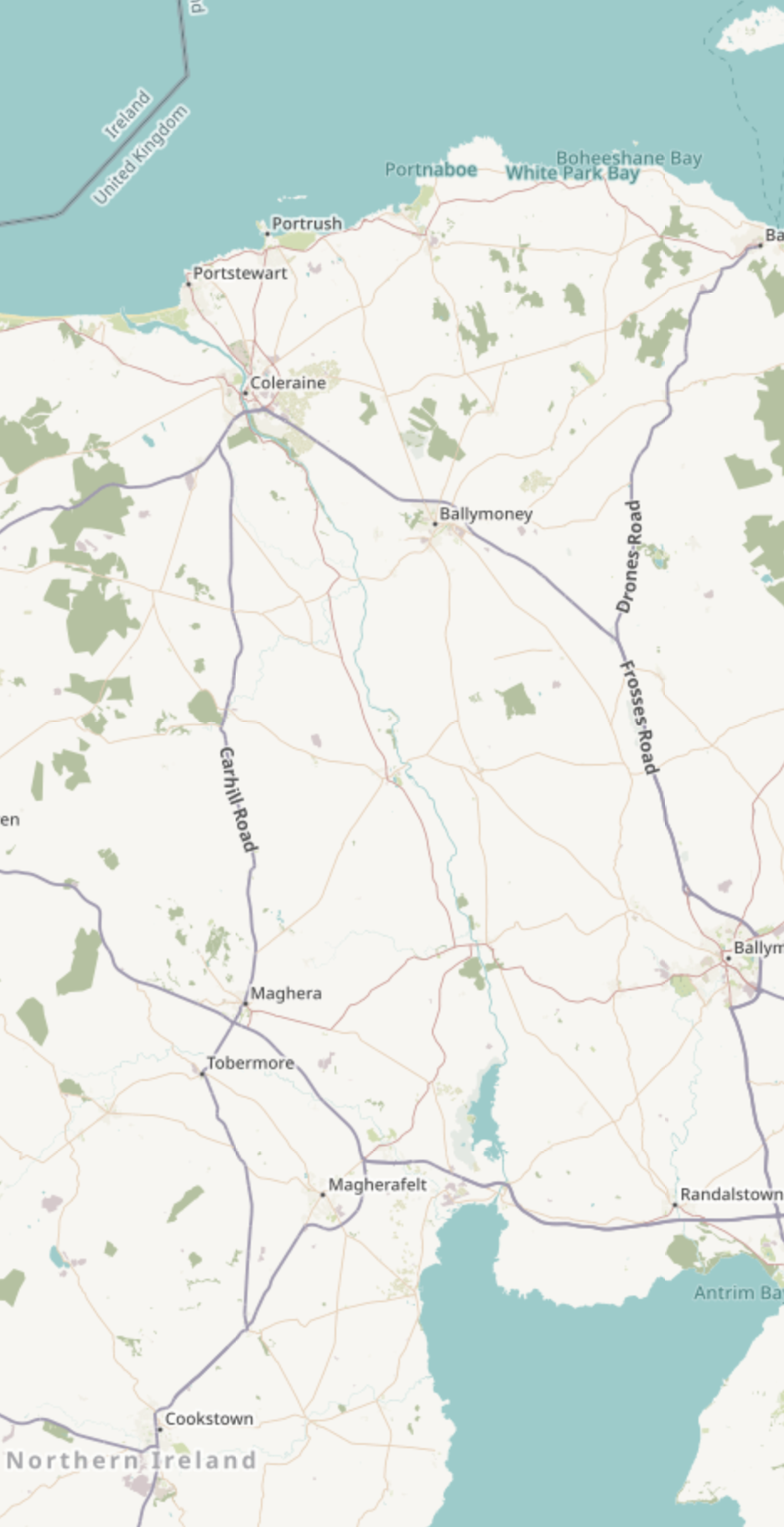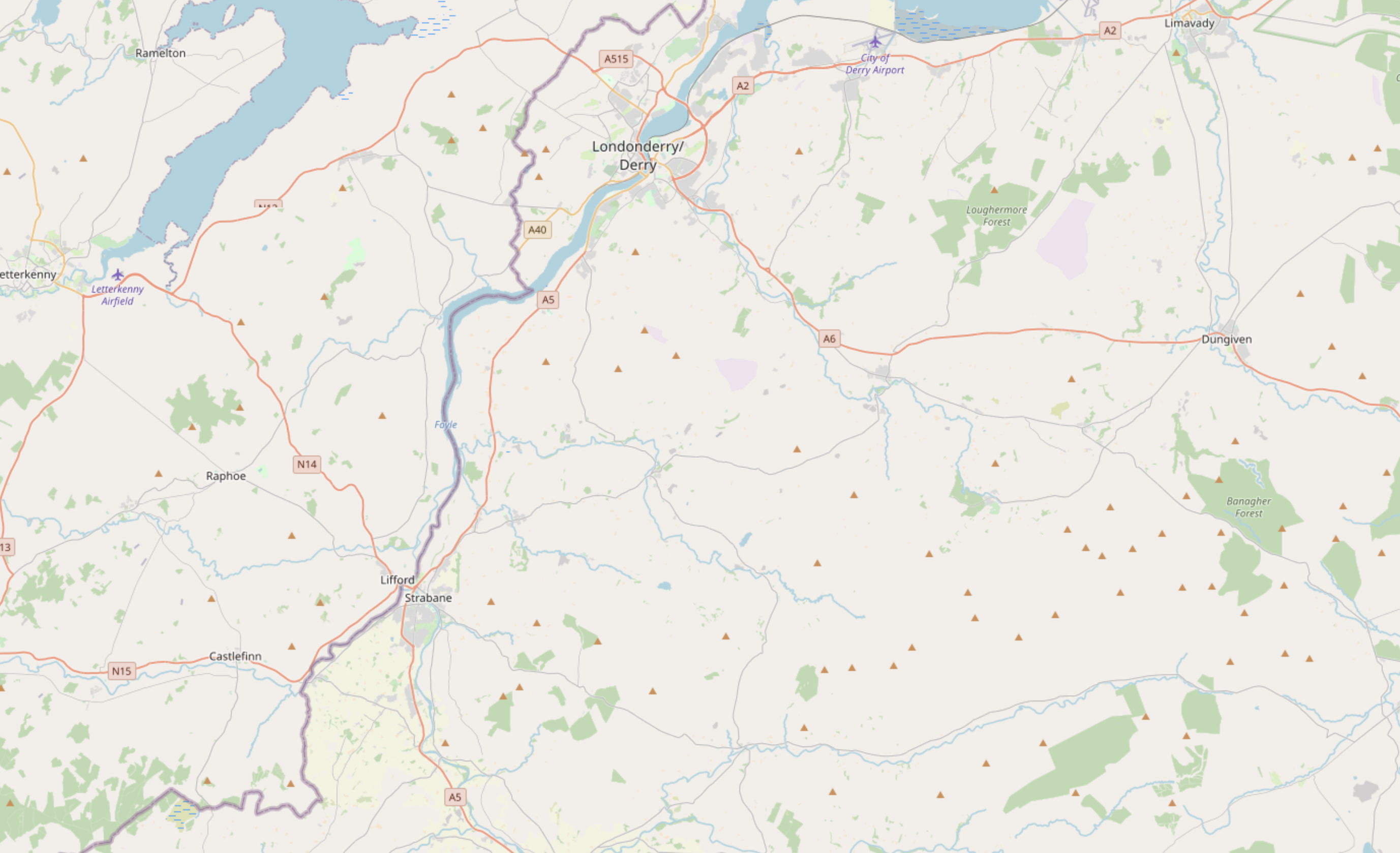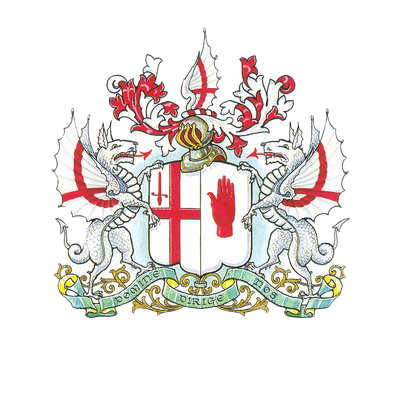Fishing
Locations
Lower Bann Tributaries
The tributary rivers – Macosquin, Agivey, Ballymoney, Clady, Moyola and Ballinderry – of the Lower Bann and Lough Neagh are vital as spawning and nursery rivers (there is very little spawning ground left in the main river itself, following the centuries of dredging and navigation). These have been much enhanced during the last decades thanks to the tireless efforts of local angling clubs, several of which operate hatcheries to augment wild salmon, trout and dollaghan stocks, together with government and EU funding and assistance from fishery owners such as The Honourable The Irish Society.
All the tributaries provide excellent game fishing at very reasonable prices, especially on the back of a flood and later on in the season (August-October). Visitor permits on all these rivers are now being managed via Cressabelle. Local knowledge is useful, and guides can be arranged for the visitor. More details about each tributary are set out below.
The Macosquin River is a small 3-5m wide river which flows into the Lower Bann close to Coleraine. The main quarry in this river is brown trout, of which there is an abundance. However, the river also yields an occasional sea trout and salmon in the autumn. Angling is restricted to fly fishing only and the river is under the control of the Coleraine Anglers Association.
All Salmon and Sea Trout must be returned alive and unharmed to the water after capture.
Eight visitor rods are available daily, from via Cressabelle.
The Ballymoney Burn flows through the famous market town of Ballymoney to the east bank of the Lower Bann. This small river is known locally for its brown trout fishing, although small numbers of salmon and sea trout also enter the river in the autumn. The river is fishable only for the last couple of miles below Ballymoney, with the best trout angling around the village of Balnamore.
The Department of Agriculture, Environment & Rural Affairs leases the fishing rights from The Honourable The Irish Society. Four visitor rods are available daily, please contact Cressabelle.
All Salmon and Sea Trout must be returned alive and unharmed to the water after capture.
The Agivey river runs north east off the Sperrin Mountains into the Lower Bann near Ballymoney and is probably one of the best medium sized salmon and grilse rivers in Ireland – a fact largely due to the extensive management and enhancement of the river by the Agivey Anglers Association over past decades, which has resulted in the formation of some ideal habitat and angling stretches. Salmon start to run the river from May onwards, and numbers peak towards the end of August, depending, of course, on water flows. September can also be a productive month. In addition to salmon, the river and particularly its tributary the Wee Agivey also hold an excellent head of resident brown trout which will give an angler exciting dry fly sport throughout the season.
Eight visitor rods are available daily, via Cressabelle.
All Salmon and Sea Trout must be returned alive and unharmed to the water after capture.
The small-to-medium sized Clady River flows from the Sperrin Mountains down through the historic linen village of Upperlands and past Culnady and Clady before emptying into the Lower Bann below the town of Portglenone. The river has a very good stock of wild brown trout where it meets the rich, flat agricultural land around Culnady. Here the river was sympathetically dredged a number of years ago and there are now plenty of deep pools and good riffles. The river requires decent rainfall to fish well and weather permitting enjoys a good run of salmon from August through to the end of the season. The water is leased to Clady & District Angling Association, which has also built an excellent angling centre with good disabled access, close to Clady Village.
Eight visitor rods are available daily via Cressabelle.
All Salmon and Sea Trout must be returned alive and unharmed to the water after capture.
The Moyola River runs through some of the most beautiful countryside in Northern Ireland, flowing 27 miles from the Sperrin Mountains to Lough Neagh, close to the village of Toome where the Lower Bann emerges from the Lough. It is here that the returning adult salmon join the native dollaghan (large brown trout which migrate to Lough Neagh, before returning to their native rivers to spawn) on their journey upstream. Wild brown trout are also found in abundance.
For nearly all of its length the Moyola flows at suitable speed over gravel into pools, making it excellent fly fishing water. The river is managed and enhanced by the Moyola Angling Association, which has also invested in a hatchery. Eight visitor rods are available daily, via Cressabelle.
All Salmon and Sea Trout must be returned alive and unharmed to the water after capture.
The Ballinderry River flows eastwards through the borders of Counties Tyrone and Londonderry. It rises in the foothills of the Sperrin mountains, twists its way through the Kildress countryside to Cookstown, on to Coagh and finally flows into Lough Neagh.
The Ballinderry River is quite rightly thought of as one of the best brown trout rivers in Northern Ireland. The best times for dry fly fishing are from late April to early June, especially when Hawthorn flies are hatching. The season starts on the first day of March and ends on the last day of October. The Ballinderry also has runs of salmon and dollaghan trout (a species that migrates to and from Lough Neagh) from September onwards, but runs can be as early as July given the right amount of rain.
Eight visitor rods are available daily, via Cressabelle.
All Salmon and Sea Trout must be returned alive and unharmed to the water after capture

Agivey River
1 of 6Macosquin (Rhee) River
2 of 6Clady River
3 of 6Moyola River
4 of 6Ballymoney River
5 of 6Ballinderry River
6 of 6Lower Bann Private Beats
Cutts beat lies at the head of the Lower Bann estuary, below the historic salmon traps at Coleraine
The Cutts beat is a stretch of about 1 mile at the head of the Lower Bann estuary at Coleraine, where the river passes over a ridge of rock, on top of which are situated the historic disused salmon traps, and descends over a rocky slope onto smoother waters below. The site is further enhanced by the nearby presence of Mountsandel Fort, one of the earliest known sites of human habitation in Ireland. Salmon and sea trout are the main quarry on this stretch of the river. Although the beat is currently not let, two day rods @ £10 each may be booked through the The Honourable The Irish Society’s the Coleraine Office.
Situated at the first weir on the Lower Bann and one of the finest Salmon beats in Ireland.
The highly oxygenated tailwater encourages fish to hold in the area on their passage upstream providing a superb angling opportunity. The average catch for the past five years is over 450 fish per year. The fishery now has a mandatory catch and release policy. A Resident ghillies are available at all times. The fishery has a six rod limit for day tickets and six rods for syndicates, sold in separate morning and afternoon sessions. Both fly and bait fishing are permitted, but worming and multiple hook spinners are banned. The peak season is June to August, although September can also yield good bags.
Day Tickets can be booked through the Coleraine Office.
An attractive, unspoiled beat of about 3/4 mile lying between Movanagher weir and Culiff Rock, just north of Kilrea.
The beat is under the day to day control of the Movanagher Angling Club, but there are two rods reserved each day for visiting anglers which may be booked via the Coleraine Office.
This beautiful streamy beat contains a substantial stretch of the old unaltered riverbed and presents excellent fly fishing opportunities. There are five pools and wading is feasible, although care needs to be taken. The dry fly fishing for brown trout, particularly sedge fishing on summer evenings, can be very exciting and trout up to 8lbs in weight have been caught on this stretch. The salmon fishing can be first rate, particularly if the water is low and fish linger in the area prior to running the weir upstream.
All Salmon and Sea Trout must be returned alive and unharmed to the water after capture.
Lower Bann, near Movanagher.
Situated at a natural bend and narrowing of the river between Carnroe and the lower end of the Movanagher beat, Culiff Rock is a powerful, fast flowing stretch of the Lower Bann. In periods of medium to low water, the beat can fish consistently well for fly fishing and, depending on water conditions, spinning and bait fishing (barbless single and double hooks only), which are also allowed can prove successful. Although salmon are most plentiful between June and September this beat is also renowned for its season-long brown trout fishing, with specimens of 6-7lbs being caught regularly. Two boats with oars are available for use by anglers.
Season rods can be booked the Coleraine Office.

Carnroe
1 of 4Movanagher
2 of 4Culiff Rock
3 of 4Cutts Beat
4 of 4The Foyle and its tributaries
The Foyle is the major waterway in the North West of Ireland, with a long history of commercial and recreational salmon fishing.
The river drains out of Counties Donegal, Londonderry and Tyrone, and The Honourable The Irish Society owns fishing rights in a number of the smaller branches of the system: the rivers Roe, Faughan, Dennett and Strule, as well as some stillwater fishing around Derry-Londonderry. The system as a whole enjoys a larger run of Atlantic salmon than any other river in Northern Ireland, along with numerous sea and brown trout. These rivers are mostly licenced for daily management purposes to angling clubs and community organisations. However, there are daily reserved rods on most of them that can be accessed via Cressabelle.
A limited number of salmon and sea trout may be taken subject to the enforced Loughs Agency regulations.

River Roe
1 of 6River Faughan
2 of 6River Dunnett
3 of 6River Strule
4 of 6River Derg
5 of 6Enagh Loughs
6 of 6The Faughan is a medium sized river (5-20m wide) which rises on the flanks of Sawel, the highest of the Sperrin peaks. It makes its way north-west along a scenic valley through the villages of Park and Claudy, before turning north through Drumahoe on the edge of Derry-Londonderry and entering Lough Foyle. It is a renowned spate river for salmon and sea trout and is under the daily management of River Faughan Anglers Ltd, which licences the rights from The Honourable The Irish Society. 8 visitor day rods are available via Cressabelle.
The Burn Dennett is a medium sized (5-20m wide) spate river that rises on the northern slopes of the main Sperrin Mountain ridge. It flows northwards through Donemana, then swings west through native woodland and pasture before meandering across broad flats to reach the River Foyle some miles upstream of Derry-Londonderry. Sea trout peak from June-August in this river, with grilse available from July to August and salmon in August and September. The river is under licence to the Dennett Angling Association, which has done much good work to improve stocks and habitat. 8 visitor day rods are available via Cressabelle.
The Roe is a medium sized river (5-20m wide) which rises high in the Glenshane Pass in the Sperrin Mountains, dropping rapidly to Dungiven village. The spate river then makes its way northwards through the beautiful Roe Valley Country Park before meandering across the broad Lough Foyle lowlands to the sea. Most of the fishing is under the management of the Roe Angling Association, under licence from The Honourable The Irish Society, although some stretches are in private or government ownership. Sea trout fishing starts the season on the Roe, with fine runs from late June to August. Salmon fishing is at its best from August onwards, proving most productive in spate conditions in the mid section of the river. 8 visitor day rods are available via Cressabelle.
The River Strule is a large (30m-50m) spate river flowing from Omagh northwards through Co Tyrone until it meets the Derg some miles upstream of Sion Mills village, when it becomes the Mourne. It has a good run of spring salmon (best from April to mid-May), with most of the grilse and salmon arriving later, from June to July. However, good fishing can still be had in September and October. The Honourable The Irish Society owns some fishing rights at Rocks Lodge on the East (right) bank of the Strule just below Newtownstewart, where a new weir provides well-oxygenated fast flowing water for almost half a mile of single bank salmon and trout fishing downstream. There is no club or syndicate on this stretch and bookings for up to 8 rods daily are available via Cressabelle. Access is via a shared car park with an adjacent fish farm, and anglers must obey all hygiene precautions and directions from the fish farm.
The Derg is a large (10-20m wide) spate river with a fine head of wild brown trout. It is best known for summer salmon, grilse and sea trout which are generally at their best from late May through to August. Some fresh water is required to encourage runs of fish, although grilse and sea trout will edge upstream without a flood. The river has its source high in the Donegal hills, flowing out of Lough Derg and eventually joining with the River Strule to form the Mourne, downstream of Newtownstewart village. The Honourable The Irish Society licences its rights on the lower part of the river, below Crewe Bridge, to the Ardstraw Angling Association, who manage the fishery. 8 visitor day rods are available via Cressabelle.
The Eastern of twin Loughs just 4km outside of Derry-Londonderry, this 14 hectare body of stillwater lies just off the A2 dual carriageway road towards Limavady and is easily accessed with a road running past much of the margin. The Lough is not stocked and instead has a head of pike and coarse fish, mainly roach and perch; the fishing rights are currently managed by Enagh Country Park Enterprises Ltd but the Irish Society has reserved 8 day rods which are available for booking via Cressabelle.
